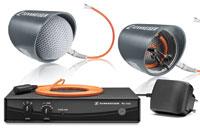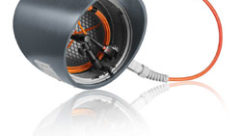

Optical Mics: Hear the Light
Fiber optics have been widely used in pro AV for years, so maybe it was only a matter of time before the technology started showing up in microphones, too. Old Lyme, Conn.-based Sennheiser is the latest vendor?and one of the few?to offer a microphone that uses optics rather than electrical signals to capture and transmit sound.
Fiber optics have been widely used in pro AV for years, so maybe it was only a matter of time before the technology started showing up in microphones, too. Old Lyme, Conn.-based Sennheiser is the latest vendor–and one of the few–to offer a microphone that uses optics rather than electrical signals to capture and transmit sound.
The underlying concept is relatively straightforward. A light source–usually a light-emitting diode (LED)–shines against the diaphragm, and the reflections are picked up by a photodetector that’s on the same side of the diaphragm. When the diaphragm moves, so do the reflections, creating changes in light intensity. The photodetector notes these changes, beginning the process of capturing them as sound waves. The light waves travel along a fiber optic cable to a unit that, besides providing power, includes a photodiode that converts the light into electrical signals.
In the case of the new Sennheiser MO 2000 optical microphone, the design yields a maximum sound pressure of 34 dB and a frequency response of 20 Hz to 40 kHz. That range is beyond what most human ears can detect, which is one of the reasons the mics are aimed at applications such as listening for natural gas leaks that otherwise would go undetected.
Selling Security?
Sennheiser’s new mics, along with those from rivals such as Israel-based Optoacoustics, are aimed primarily at specific vertical markets such as oil and gas, health care, and transportation. But that focus doesn’t rule out a wider range of applications.
“It will be interesting to see where it’s picked up and what kind of interest it garners,” says Vanessa Jensen, product manager for installed sound at Sennheiser. For example, optical mics are a potential fit for high-security environments, such as government and defense contractor offices, where eavesdropping is a concern.
That’s because the alternative–mics with copper cables–even when they’re shielded can double as antennas, radiating whatever content is traversing them. How far those “broadcasts” travel depends on factors such as whether there are multiple walls in the area to attenuate the signal. But if the copper cables are in, say, an executive conference room that has lots of windows, there’s a better chance that the signals can be picked up by someone in the parking lot below.
That scenario is one of the reasons why many government guidelines, such as the National Security Agency’s TEMPEST, require fiber for secure applications. Often, the concerns such guidelines address often apply to the general enterprise market, too.
Regardless of the market, optical microphones are one way to address various security issues because neither the cable nor the mic itself use electrical signals to capture and convey sound waves, so it’s much more difficult, though technically not impossible, to eavesdrop on them.
Identifying such security risks and then educating clients on the value of a mic alternative are especially important when it comes to optical mics, in part because of their price tags. (The MO 2000, for example, lists for $3,000.) The same thing goes for vendors, which must help integrators understand the types of applications where pricier, optical mics might be a good fit.
“Typically the high-security environments have been okay with a hard-wired mic and haven’t pushed for more, although that requirement could change,” says Eric Snider, senior engineer at St. Louis-based Conference Technologies, an integrator that sells into the government and defense markets but hasn’t tested the Sennheiser mics.
Some integrators and other companies have inquired about the MO 2000 and the IAS MO 2000, a $4,200 version that includes a weather protection kit and is certified for explosive environments. “The majority of the interest that we’ve seen has been to understand the technology and listen to it,” Jensen says.
Some potential users have focused on the cable: Sennheiser’s products have a 3 meter cable standard, although longer lengths are available as a custom build. Between those requests and what competitors offer, Sennheiser is considering changing the cable length. “They [Optoacoustics] are standardizing their cables at 10 meters, so that’s something we’re looking into doing because we have so many requests for longer cables,” Jensen says.
Immune to Interference
By relying on light in both the capsule and cable, optical mics also are inherently immune to electrical interference, such as from nearby cell phones. That design eliminates the chattering sound that many phones–particularly GSM and iDEN models–introduce into PA systems. “It’s not going to be susceptible to the same types of interference that a lot of mics are,” Jensen says.
The use of light waves rather than electrical signals is a major reason why the mics are aimed at the health care market. For example, the mics don’t interfere with magnetic resonance imaging (MRI) machines’ magnetic fields, nor are they susceptible to those fields. That means patients can use them to communicate with tech and physicians during scans.
Optical mic technology also could wind up in the devices that cause interference in the first place. For example, a patent application from 2004 cites cell phones as a potential application, partly because the close proximity between the mic and handset’s transceiver increase the likelihood of interference.
That application could prove noteworthy for pro AV, particularly if it means more manufacturers start developing optical mics, thus producing more innovation and driving down the cost of the technology. For now Sennheiser is still feeling out the market. “It’s a learning experience for us,” Jensen says.










